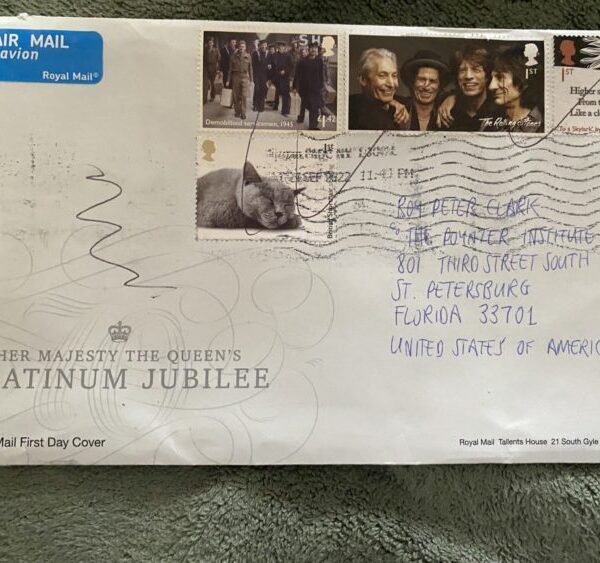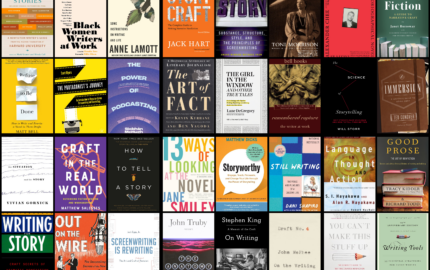EDITOR’S NOTE: This essay is shared with our friends at The Poynter Institute by request of the author.
* * *
Early last October I received a small package from England, which looked most interesting even before I opened it. The envelope celebrated “Her Majesty the Queen’s PLATINUM JUBILEE.” Five stamps carried the postage, each with a distinctive image: Soldiers from WWII; three lines from my favorite Shelley poem, “To a Skylark”; four members of the Rolling Stones; and a gray cat with its eyes closed.
When I flipped it over, it was sealed with a Mick Jagger stamp and hand-written note: “He also can’t get no satisfaction….”

I was intrigued. Whoever sent this seemed to know something about my interests and sensibilities. The sender was a writer named Paul Khanna. He described himself as a scribe who was, like Jagger, not getting satisfaction from his work; no mention of his acting career. He had written three diet books and had taken a course on screenwriting during the pandemic. He experienced personal setbacks. Both parents suffered serious illnesses and his cat went blind. (I thought of that stamp of a gray cat with its eyes closed.)
What did he want from me? It turns out he had read two of my books and found them helpful. He then caught a notice of my new book, “Tell It Like It Is: A Guide to Clear and Honest Writing,” due out April 11. He wanted a preview copy. “Just like the Apollo 13 which launched on that day,” he wrote, “I’m feeling lost in space and can’t wait to find my way home.”
Along with his letter he sent a tiny notebook he had created, a few pieces of paper stapled together with a request: “With some distance from writing ‘Tell It Like It Is,’ perhaps you could scribble some key thoughts down from it.” He included a self-addressed return envelope and $25, enough for postage, coffee and a “juicy muffin.”
He was asking, in essence, that I write him a mini-book, a personal anthology of my thoughts on writing.
At first, I was put off by the brashness of the request. But then I thought Why the hell not?
More and more, it seems to me, what a writer remembers is often the most important.
I would select my favorite bits of advice, not just from the new book, but from the six that preceded it — the kind of practical strategies that work best in my coaching and teaching. I finished the project in one sitting, writing by hand in the makeshift journal, without reference to any of my books. More and more, it seems to me, what a writer remembers is often the most important.
A lifetime of writing advice
As you read these here, you have to imagine them scribbled across the page in black ink from a green Poynter Institute pen. The numbers correspond to the order in which they were written.
1. A page a day equals a book a year.
2. Good writing is not magic. It’s a process, a set of steps.
3. My process: Find an IDEA, collect STUFF. Find a FOCUS. SELECT your best stuff. Decide on an ORDER. Write a quick DRAFT. REVISE.
4. The antidote to procrastination is REHEARSAL, writing it in your head.
5. The antidote to writer’s block is lowering your standards. You can raise them later.
6. Draft earlier than you think you can. Not even a first draft, but a Zero Draft.
7; You don’t need to tell everything in the first sentence. But it should grab the reader’s attention.
8. Use shorter words, shorter sentences, shorter paragraphs at the points of greatest complexity.
9. Shakespeare did not write “The Queen is dead, my lord.” He wrote “The Queen, my lord, is dead.” Place emphatic words at the end. Stick the landing.
10. It helps to have a daily writing habit.
11. If you get stuck, step away. Come back and write — by hand — quickly.
12. Read your work aloud, to yourself, to others.
13. Get a good human voice in your story. Let that person speak early.
14. Reports give readers information:
Who
What
Where
When
Why
15. Stories give readers experience:
Characters
Scenes
Settings
Chronology
Motives
16. Stories need: Details of character. Action in scenes. Dialogue. Points of view. Stories are a form of transportation across time and space.
17. For clarity:
Subjects + verbs together.
Slow the pace of information. Shorten sentences.
Avoid or translate jargon.
Too many numbers can be numbing.
Avoid clutter, especially at the top.
Introduce characters or concepts one at a time.
18. Reward the reader with “gold coins”, especially in the middle. Gold coins = anecdotes, examples, good quotes, interesting facts.
19. Read widely and deeply. Read the kind of thing you want to write.
20. Keep examples of the best passages you are reading. Talk about them with other writers.
21. My favorite writing virtues:
Patience
Confidence
Empathy
Curiosity
Versatility
Coffee!
22. Embrace your identity as a writer. You are a writer because you write.
23. Grammar is really glamour, practical magic.
24. Learn to live inside of words. The sounds, the history, the connotations.
25. If you want to write a book, find an agent. Mine has really helped me.
26. Read “The Uncommon Reader” by Alan Bennett. The Queen is alive — and reading!
27. Read. Write. Talk about reading and writing.
28. Set an earlier deadline than the one you have. If your work is due on January 1, make believe your deadline is November 1.
29. Revision is not just proofreading. You can revise all parts of the process. You can revise your revisions.
30. Write a mission statement for your work.
31. Break a big project into its smallest parts.
32. The bigger, the smaller. Find objects with stories hiding inside of them.
33. Craft is neutral. Connect your craft to a noble purpose.
Rereading these, I can’t help but notice:
- The influence of other writers and teachers, especially writing coach Donald Murray, who shared so many of these with me. Generous writers and editors pass along their best tips to others.
- The important connection between reading and writing, and the need to think and talk about how reading and writing make meaning.
- The way in which confidence and craft bolster each other.
- The idea that each writer must find their own way, even as they try to solve the problems all writers face.
- The most helpful writing books help us both perfect our craft and also lead productive writing lives.
Thanks to Paul Khanna for inspiring these reflections.
Writing with purpose
In a subsequent message, I asked Paul if any of the ideas or strategies resonated.
He answered: “Everything had truth in it, so everything resonated. But one thing grabbed me by the collar: ‘Craft is neutral. Connect your craft to a noble purpose.’ This was the antidote to my feelings, being full of craft with nothing to say. When I read ‘a noble purpose,’ the lightbulb went on.”
In closing, I’d like to add a Number 34 to my list. It comes from British novelist David Lodge, who argued that writers cannot afford to ignore any expression of language, high or low, whether they find it on the back of a box of Frosted Flakes or spray-painted on a subway wall.
I looked at that envelope again. Who would have thought I could find this inspiration on a postage stamp?
Higher still and higher
From the earth thou springest
“To a Skylark,” by Percy Bysshe ShelleyLike a cloud of fire



